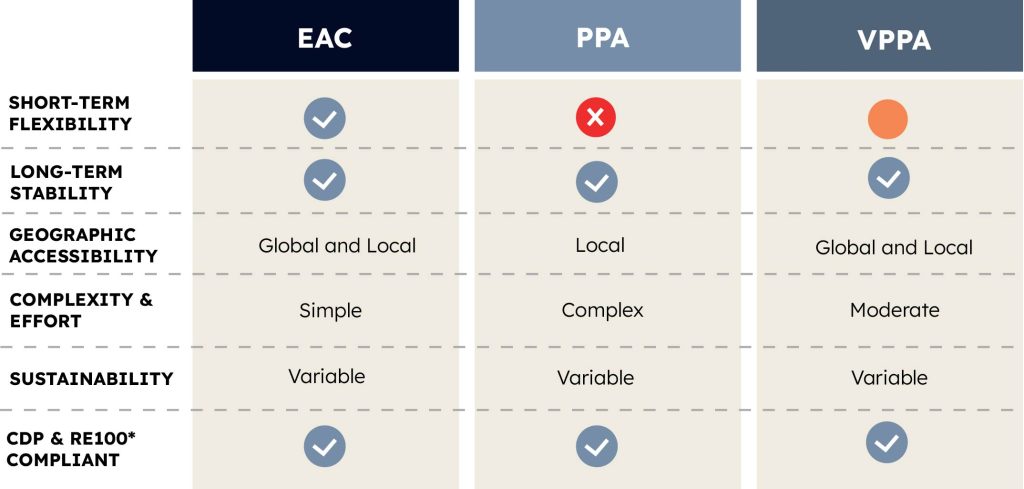In the dynamic landscape of corporate sustainability, the pursuit of renewable electricity sources has evolved into a strategic imperative for businesses worldwide. Amid this transition, three primary avenues stand out: Energy Attribute Certificate (EAC), Power Purchase Agreements (PPAs), and Virtual Power Purchase Agreements (VPPAs). Each holds distinct benefits and risks, but as we embark on this journey, it is essential to unravel these options to find the most fitting solution for your company's sustainability goals.

Power Purchase Agreements (PPAs)
PPAs are revered for their direct engagement with renewable energy producers. They offer a long-term, stable commitment to purchasing electricity from specific facilities. By entering a PPA, a company effectively supports renewable energy projects and secures a fixed price for the energy generated. PPAs gained notoriety as companies with large electricity usage such as tech companies with an expanding network of data centers looked to reduce their scope 2 emissions. However, while PPAs promise stability, they often come with lengthy contractual commitments (up to 25 years), potential geographical limitations tied to the energy source's proximity, and risks associated with market fluctuations.
Virtual Power Purchase Agreements (VPPAs)
VPPAs emerged as a strategic response to some of the limitations inherent in traditional PPAs. As PPAs deliver both the environmental attribute and the physical power, VPPAs allow those that do not have proximity to the generation source to join in on the benefits of long-term renewable electricity investment agreements.
Most VPPAs structure the volume as “pay as produced.” This means that the financial aspects, such as the price hedge and green claim, depend on the actual production volume of the renewable asset. The buyer commits to purchasing a variable amount of renewable energy over a set period, directly tying their financial commitment to the actual energy output of the project. This structure provides flexibility, as the buyer’s financial obligations are based on the actual energy generated. It ensures a direct link between the produced volume and the buyer's financial benefits and environmental claims, promoting transparency and alignment between the buyer and the project’s performance.
WHITE PAPER: Recent trends in the renewable electricity markets
DOWNLOAD NOWEnergy Attribute Certificates (EACs)
Amidst the landscape of procurement options, Energy Attribute Certificates (EACs), or Renewable Energy Certificate (RECs) in North America, emerge as a versatile and accessible avenue for companies seeking renewable energy solutions. EACs represent the environmental attributes of energy generated from renewable sources, detached from the physical electricity. Unlike PPAs and VPPAs, EACs provide unmatched flexibility. Companies can procure renewable attributes independently of geographical constraints, not tethered to specific locations or facilities.
Flexibility and ease of procurement characterize EACs, making them a compelling choice for companies of various sizes and structures. Unlike PPAs and VPPAs, EACs offer a more accessible entry point into renewable electricity sourcing. They allow companies to reduce their carbon footprint without directly engaging with energy producers or requiring long-term contracts, though they have the ability to be hedged out to 10 years. These certificates cater to entities facing time constraints with minimal patience for returns on investment, offering a swift procurement process. Additionally, for businesses with low risk tolerance, prioritizing uninterrupted service, unbundled EACs prove advantageous by detaching from geographical limitations, ensuring flexibility and reliability in sustaining their operations without reliance on proximity to energy sources. While PPAs and VPPAs present viable options, the inherent flexibility and accessibility of EACs make them the preferred choice for most companies navigating the complex terrain of renewable energy procurement.
Optimizing Renewable Electricity Procurement
In the quest for sustainable energy, it is crucial to plan ahead regardless of your chosen path. There is a growing consensus that carbon prices will rise, which could make sustainability commitments harder and costlier. This challenge might affect how companies stick to their green goals in the long run, without jeopardizing their budgets and competitiveness. However, with 2030 just around the corner, there are also lots of opportunities and tools available to mitigate emissions without compromising the core business.
Rather than relying on one-time RFP structures, consider partnering with a sustainability professional in the long run, so they can guide you and help you optimize your investments throughout the year. Many of our customers have been surprised to find out that releasing an RFP of over $200k (notional) into the market can dramatically increase the market price and result in a worse deal for your quarterly or annual procurement. Instead of trying to perfectly time the market yourself, working with a market expert who can design the optimal hedging strategy, such as our HedgeZero solutions, when procuring renewable electricity to protect your business against market fluctuations and financial risks.
We Can Help
STX Group encourages enterprises worldwide to establish GHG emissions reduction targets aligned with scientific principles and the Paris Agreement. Additionally, a detailed evaluation of reduction opportunities, guided by the Science Based Targets initiative or ISO 14068, should be carried out to address direct and value chain emissions in a scientifically supported manner.
We understand the challenge of meeting substantial energy demands without compromising fiscal responsibility. STRIVE by STX aims to guide companies on their journey to self-sufficiency in renewable electricity sourcing, facilitating a transition towards comprehensive decarbonization while ensuring additionality. Start your climate conversation and connect with our experts to jointly develop an optimized renewable electricity procurement strategy for your organization.
